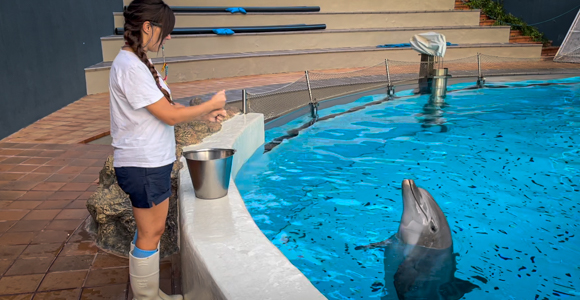
Do animals have a sense of time?
There is a growing scientific awareness that animals may have cognitive abilities and that they are not just biological machines driven by instinct. Biologists from SDU are now investigating dolphins' and porpoises’ understanding of time.
Do animals understand that time exists? Can they recall events from the past and imagine the future? Or can only humans do that?
Sara Torres Ortiz studies animal cognition and together with colleagues from the Department of Biology, she is currently investigating whether dolphins can understand time as a part of a larger international project.
- Basically, we don't know very much about whether animals, like humans, are capable of mental time travel, that is using their imagination to travel back and forward in time, she says.
Crows, parrots and bats
If animals have an understanding of time and, for example, can plan for the future, it may have implications for the way we think about animal welfare today, she said:
- If animals have an understanding of time, the way we treat them may cause unnecessary suffering. For example, keeping them restrained even for a short period may result in stress also after release. We may therefore need to rethink the way we keep, treat and transport animals in the future.
In addition to SDU's dolphin studies, the project also includes studies of bats from Johns Hopkins University in the USA, while the Max Planck Institute for Ornithology in Germany contributes with studies of parrots.
The project "Mental 3D space-time travel in fission-fusion animal societies" is funded by the Human Frontiers Science Program with 1.54 million dollars, and the principal investigator is associate professor Magnus Wahlberg, Department of Biology at University of Southern Denmark.
The scrub jay that knew when a worn was too old
- In this experiment, scrub jays were given the opportunity to store fresh worms and dried peanuts as reserves. After a while they were allowed to retrieve their stashed food.
- If a long time had passed, they went for the peanuts first. If a short time, the worms.
- The birds searched preferentially for fresh worms if they had cached them 4 hours earlier but rapidly learned to search for peanuts and avoid decayed worms that had been cached 124 hours previously.
One may think that most animals must have an understanding of time - why else does a dog become restless when feeding time approaches? And why can a squirrel find its way back to the place where it hid food weeks before?
According to Sara Torres Ortiz, these cases are not examples of understanding time.
As for the squirrel, its more an example of an animal with innate instincts that – free of conscious decision making – controls its behavior (also applies to, for example, migratory birds that know when to leave). As for the dog, it learns through so-called associative learning that there is a connection between an event and its owner's behavior.

Photo of trainer with two fingers pointing at dolphin: This hand sign means that the dolphin must remember a certain behavior.
 Clenched fists on top of each other, means that the dolphin must perform the behavior that they were asked to remember.
Clenched fists on top of each other, means that the dolphin must perform the behavior that they were asked to remember.
Whatever processes are at play in these animals, they take place in the more primitive part of the brain; the amygdala. In contrast, more complex cognitive processes take place in the cortex and hippocampus, and these brain parts are needed to create a more conscious understanding of time, so that an animal can, for example, intentionally plan into to the future.
Does a dolphin remember the past?
Can animals remember the past? Can they use lessons learned to plan for the future? Can they keep track of time? To ensure that associative learning is not at play, the animals are presented every day with new times, new places and new rewards.
”If animals have an understanding of time, the way we treat them may cause unnecessary suffering. For example, keeping them restrained even for a short period may result in stress also after release
In the morning, they are presented with two symbols, behind which are hidden respectively a fish and a piece of gelatin. Both are attractive food items for a dolphin, but they would rather have the fish than the piece of gelatin.
The first step is to find out which food item is hidden behind the two symbols. Next, they learn that the container with fish is refilled less often than the container with gelatin: Fish is only available every three hours, while the gelatin is available once an hour.
Once the dolphins have learned this, they are presented with the same symbols elsewhere in their pool at different times.
This allows them to show if they have learned that it is not worth coming back to the symbol for fish before three hours have passed – but that it is well worth coming back to the symbol for gelatin already after one hour.
The chimpanzee that made plans
How short can a sound be?
Another test involves asking the dolphins to answer how they perceive the duration of a sound. Sara Torres Ortiz and her colleagues do this by first teaching the dolphins the difference between two symbols that mean "same" and "different", so that the dolphins can answer "same" or "different" when they are presented with, for example, sounds of variable duration.
- We want to find out if they understand that one sound can be longer than another and therefore is "different". We also want to know how short a sound they can pick up, she explained.
Animals such as dolphins, other toothed whales and bats operate with extremely short sounds when they hunt and capture prey using echolocation.
- It only takes them milliseconds to locate and catch a prey, so it is interesting whether they perceive milliseconds differently than, for example, humans. It's a time scale that we humans don't operate on at all, she says.
The SDU's dolphin studies take place in Loro Parque on Tenerife and include eight dolphins, all trained to work with researchers. The porpoise studies take place at Fjord&Bælt in Kerteminde, Denmark.
Meet the researcher
Dr. Sara Torres Ortiz is a biologist with special interest in animal cognition, e.g. how they think, solve problems and communicate. She is a postdoc in the research group "Sound and Behavior" at the Department of Biology.